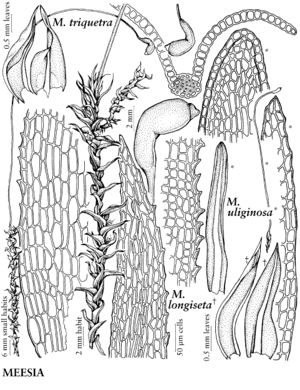familyMeesiaceae
genusMeesia
Show Lower Taxa
Meesia
Sp. Musc. Frond., 173, plate 41, figs. 6 – 9. 1801.
Etymology: For David Meese, 1723 – 1770, Dutch gardener
| Taxon | Illustrator ⠉ | |
|---|---|---|
 | Meesia longiseta Meesia triquetra Meesia uliginosa | Patricia M. Eckel Patricia M. Eckel Patricia M. Eckel |
Leaves erect to widespreading, some species 3-ranked, ligulate to ovatelanceolate; margins plane to reflexed basally to recurved throughout; laminal cells irregularly isodiametric to short-rhombic, surface not bulging, smooth, walls firm; basal-cells longer than distal cells.
Distribution
North America, Mexico, Central America, South America, Europe, Asia, Africa, Pacific Islands (New Zealand), Australia
Discussion
Species 12 (3 in the flora).
Meesia occurs on calcareous soil banks and in rich fens in boreal, alpine, and arctic habitats. The quadrate distal laminal cells differentiate Meesia from Amblyodon dealbatus, which has elongate, pellucid laminal cells.
Selected References
None.
Lower Taxa
Key
| 1 | Leaves ligulate to narrowly lanceolate, not 3-ranked, erect when moist; margins revolute basally. | Meesia uliginosa |
| 1 | Leaves ovate-lanceolate to lanceolate, 3-ranked, spreading when moist; margins plane to reflexed basally | > 2 |
| 2 | Leaf margins entire; sexual condition synoicous. | Meesia longiseta |
| 2 | Leaf margins serrulate distally; sexual condition dioicous. | Meesia triquetra |
... more about "Meesia"
acute;rounded-obtuse +
longer +
naked +
cucullate +
curved +
inclined +
clavate;pyriform +
strong +
single +
crowded +
erect;widespreading +
ovatelanceolate;linear or obovate +
uniform +
not bordered +
plane +
long +
defined +
diplolepidous +
reduced +
Sp. Musc. Frond., +
1801 +
long +
ligulate +
3-ranked +
ovatelanceolate +
simple;sparsely branched +
erect;ascending +
not bulging +
Meesia +
Meesiaceae +
genus +
firm +